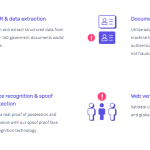3 Reasons Why Language Services are Needed in Hospitals
3 Reasons Why Language Services are Needed in Hospitals
Several laws are routinely enforced in an effort to ensure that limited English proficiency (LEP) and Deaf and Hard-of-Hearing (HoH) patients are provided meaningful access to pertinent information surrounding their healthcare and well-being. These regulations were put into effect to incentivize hospitals to provide the same level of health care services and coverage to all patient populations, regardless of their language or culture of origin. One way to ensure that hospitals adhere by these regulations—and deliver proper care to LEP/HoH patients—is by offering language services.

When LEP patients are provided with medical language services, hospitals experience an increase in LEP patient engagement, an enhancement in LEP patient-provider communication and an improvement in LEP patient outcome. Patients who are provided with clear and concise information pertaining to their healthcare and well-being tend to be more actively engaged in their care plans, resulting in shorter lengths of stay and lower readmissions. Here’s how:
See Also: How IoT is Revolutionizing Workplace Safety?
Breaking Language Barriers Boosts Patient Comfort
Patient comfort is directly correlated with higher patient satisfaction, engagement and outcome, so it’s no wonder why it’s a top concern for hospitals. Additionally, patients who are comfortable with their environment tend to have a better patient-provider relationship—and much of this comfort stems from having a firm understanding of healthcare information, plans and procedures. Therefore, any LEP and/or Deaf/HoH patient should be provided with the assistance of a medically qualified interpreter to ensure that such understanding is taking place. To ensure that patients receive communication assistance when needed, providers can collect the patient’s preferred language at intake and post the availability of language services in a clearly visible area.
Providing Clarity Can Prevent Unnecessary Procedures & Tests
Language barriers can have dangerous implications for patients; without the assistance of an interpreter, physicians may misunderstand, miscalculate or misdiagnose the LEP patient’s condition. By using a qualified interpreter, hospitals can significantly reduce the risk of miscommunication and unnecessary procedures and/or tests.
LEP and Deaf/HoH patients who are not provided with language services at the time of admission and/or discharge have been shown to experience both a longer length of stay and a greater risk of readmission within 30 days. A study by the Department of Family Medicine and Community Health & Division of Preventive and Behavioral Medicine at the University of Massachusetts Medical School found that the use of a qualified medical interpreter reduced LEP patient stay by almost a day. Shorter lengths of stay have been shown to improve LEP patient outcome and significantly lower the cost of patient care for health systems.
Proper Communication Improves Overall Patient Outcomes
Providers must disclose information pertaining to any patient treatment, test or procedure, including any risk or benefit as well as the likelihood that any risk or benefit will occur. Additionally, the patient must have the ability to make a decision, understand the information provided and grant consent without persuasion by part of the provider. This decision-making capacity of the patient can be greatly impacted by language barriers, hearing loss and/or impairment.
A recent study by the National Institutes of Health revealed that less than 45% of LEP patients were provided with interpretation, sight translation and/or document translation of consent forms in their preferred language. This indicates an underutilization of language services in healthcare. In order to ensure that informed consent is truly taking place, healthcare facilities are obligated to assess patient language needs prior to offering a service and render language services as needed. Many facilities provide documents that are routinely provided in English in the top needed languages via the use of a hospital translator. LEP patients can then review healthcare information in their own language. Others have medically qualified interpreters verbally summarize documents in the patient’s preferred language to ensure that meaningful understanding takes place. Without the assistance of language services, hospitals compromise the patient’s access to healthcare information, thus placing the outcome of the patient at great risk.
These great disparities in care can be avoided with the use of a qualified interpreter. Interpreters who are medically qualified can quickly determine when a cultural difference is negatively impacting patient-provider communication and act accordingly, resulting in seamless communication, improved patient care and outcome.
Behind the Technology Itself
With the demand for qualified interpreters on the rise in a wide variety of languages, technology is increasingly utilized to help fill the gap. There are three modes of interpretation delivery in healthcare: onsite interpreting, video remote interpreting (VRI) and over-the-phone interpreting (OPI), all of which have been greatly influenced by the advancement of technology. VRI combines the benefits of face-to-face interpretation with the on-demand nature of OPI. With just the press of a button, patients can see and hear a qualified medical interpreter in their language. Over-the-phone interpreters can be reached by any telephone, dual handset, speakerphone or cell phone. The remote nature of VRI and OPI eliminate time spent traveling or scheduling and provide access to a wider range of interpreters qualified in languages of lesser diffusion that may not be available on-site. As for on-site interpretation, mobile and desktop apps now have the capability to route on-site interpreting requests to qualified interpreters in the surrounding area, simplifying the scheduling process and improving interpreter efficiency.
With the LEP patient population rising, technology is quickly proving to be dispensable in the realm of language services. When interpreting resources are limited, technology can be leveraged to widen the scope of services provided to non-English speaking patients, ensuring that all patients are provided with meaningful access to healthcare information.
Author Bio: David leads the overall strategic direction of Stratus Video’s Language Services division and brings over 26 years of experience working for healthcare information technology and service companies. Prior to joining Stratus Video, he was president and founder of MDeverywhere, revenue cycle management software tailored to the healthcare industry.
The post 3 Reasons Why Language Services are Needed in Hospitals appeared first on ReadWrite.
(44)













